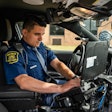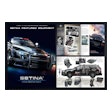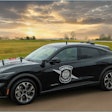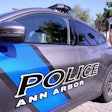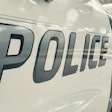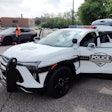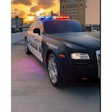This column is generally about defensive tactics or ways to give yourself an edge in a gunfight. Each month, you flip open your Police magazine and on or about this page there’s a column by a martial artist that tells you how to stun an attacker with a forearm blast or an article about what to do when your trusty sidearm jams and all hell is breaking loose.
Having a column called “Officer Survival” that focuses on ways to end an attack makes a lot of sense. Most cops believe the greatest threat facing them on the job is some prison-pumped perp with a bad attitude or some amoral gangbanger who’s out to make his name by dusting “Five-0.”
But I’m here to tell you that you face another threat, your patrol vehicle. And not taking proper care of it or driving it too far out on the edge will deprive you of life and limb as surely as any confrontation with a street criminal.
Approximately half of all officers killed in the line of duty are killed in vehicle accidents or other traffic incidents. Take a moment and just think about that. And when you’re done, you may want to make some adjustments to the way you drive.
Stay in Control
Many of you know that my agency, the Michigan State Police, has been testing cars since the early 1950s. Our current testing procedure has been used for almost 30 years with tweaks to the testing and equipment. We have even crashed cars and school buses and submerged them underwater.
Because of this interaction with cars and the manufacturers we have also studied drivers. Our driver’s education program for troopers goes as far back as the 1960s. In 1989, we opened our Precision Driving Unit at the Michigan State Police Training Academy, and we have been using it to train our officers and officers from other agencies ever since.
Through this program, our staff instructors have observed a lot of officers driving high-performance vehicles. Over the years, we’ve put officers behind the wheels of Mustangs, Camaros, Marauders, Vipers, Corvettes, Magnums, and a few hot cars that are top secret.
Allow me to let you in on a little secret. Even trained officers tend to get in trouble when they test these high-performance cars at 100 percent of their capabilities. And it’s not the car. It’s the driver. High-performance cars are perfectly safe as long as the driver doesn’t try to exceed his or her driving skills.
That’s why we specifically teach our students at the Michigan State Police to “drive at 80 percent of their ability.” In other words, always leave yourself an out.
Commercial pilots have been taught to hold 20 percent of their flying skill in reserve for decades. The same thing applies to law enforcement driving. If you drive at 100 percent of your ability and you make a mistake, there’s no room for correction. If you drive at 100 percent of your ability and encounter a hazard you were not expecting, you’re done. You will buy that hazard, lock, stock, and barrel.
So, how do you know when you’re driving beyond 80 percent of your ability? Listen to the car. Are the tires barking? If they are, back it down a little.
Finally, are you a rough driver? In our program, we preach that you should drive “smoooooooooth.” People who have attended our classes from all over the world are amazed at how well they can perform when they learn about the vehicle and then apply smoothness to their driving skills.
Know Your Number
Ever heard the expression, “His number was up?” For a lot of cops killed or injured in vehicle accidents, the “number” in question should be followed by the measurement “pounds per square inch” (PSI).
After you buckle your seat belt (and we’re assuming that you are using your seat belt), the most important thing you can do to ensure your survival during vehicle operations is to check the air pressure in your vehicle’s tires and make sure that it is correct.
I know, I know. You are sitting there reading this article and thinking that the last time you checked the air pressure in the tires of your car was as a probationary officer many years ago. Let’s face it; most police officers in this country don’t check anything on their cars before heading out on patrol. For these cops, a typical tire pressure check is performed visually. If the car is not leaning, it’s good to go and they’re off on patrol. By the way, lest you think I’m picking on patrol officers, let me say that this behavior is not limited to street cops. I’ve seen such perfunctory safety inspections performed by detectives, FBI agents, Secret Service personnel, ATF agents, and a shift commander of a major agency that will remain nameless.
So, you ask, “What’s the big deal about tire pressure?”
My answer is simple. A tire is essentially a highly engineered balloon. It works best and provides the safest driving surface when it’s inflated properly.
Overwhelmingly, the most common problem for tires is that they are underinflated. If you are driving one of the “Big 3” police cars such as the Chevrolet Impala 9C1, Ford Crown Victoria Police Interceptor, or Dodge Intrepid, your tire pressure needs to be at 35 psi cold.
Inflation of 35 psi is a magic number for these tires because they’re built for it. For the tires that fit these common patrol vehicles, an air pressure of 35 psi maximizes the contact between the tire surface and the roadway surface, which means you are getting your money’s worth of traction from the tire.
Big deal, you say. Yes, it absolutely is. I guarantee you that right now as you read this, a police officer somewhere is writing a “special” to his or her command officer about how he or she dented up a patrol car. Do you think tire pressure was considered as a contributor to the car accident? Doubtful. But it should be.
Think about it for a moment. NASCAR teams try to get their tire pressure to the nearest half pound on a Sunday afternoon for a three-hour race. And in some ways the demands they place on their tires are less than the demands you place on yours.
Your patrol car likely responds to emergencies 24 hours a day, seven days a week, 365 days a year, in all types of weather. And you drive it hard. Heck, some of you drive 100 mph just for coffee. Why then would it be any less important for you to have properly inflated tires than for you to wear a bullet-resistant vest on a drug raid?
OK. Here’s a question that I get asked a lot. Why do I advocate 35 psi cold when the sidewall of the tire says 44 psi maximum?
It’s a good question. So let me walk you through my reasoning and teach you how to interpret the information on the sidewall of your tires.
The “44 psi max.” embossed on the sidewall of your patrol car’s tires refers to maximum gross vehicle weight. To reach that weight you might have to pile 10 cops into your car and load a bazooka in the trunk. That’s an exaggeration. But simply stated, maximum inflation is for maximum gross weight, so you don’t need 44 psi unless you have a really heavy load in your car.
OK. You’re going to ask, so I might as well talk about it. Some of you have been told to use 44 psi for better cornering.
And yes, this does improve cornering. But there are some serious tradeoffs. The kind that could lead to dire consequences on the road. A higher pressure will stiffen the sidewall, but it will decrease the contact patch for emergency braking action such as a panic stop. If you find yourself needing to stop hard and fast, you will wish that your tires were at 35 psi.
Stopping Power
For some time, police cars have offered the superior stopping safety afforded by anti-lock braking systems (ABS). But ABS wasn’t offered on police motorcycles. That has now changed, and police agencies that field motor patrols should do everything they can to provide their officers with ABS-equipped bikes.
BMW was the first major police bike manufacturer to offer anti-lock brakes as a standard equipment feature. But as often is the case in the competitive environment of police vehicle sales, the success of BMW’s ABS-equipped R1150RTP has spurred other leading manufacturers to add ABS to their motorcycles.
On the Harley-Davidson Road King and FLHTPI (sometimes referred to as a “full dresser”), ABS is currently an option. And recently Honda announced that it was going to get into the U.S. police motorcycle market with the ST1300P police bike, which is ABS equipped.
Regardless of which manufacturer you choose, if you don’t have ABS on your current motorcycle fleet, make sure you get it on your next motorcycle purchase. This safety feature is so important to the motor officer that you should sell your motorcycles right now and buy bikes that have it installed.
As part of a safety study at the Michigan State Police, we examined accidents involving our motorcycle fleet and determined that, at a minimum, ABS could have substantially intervened in the majority of cases, and it could have prevented a substantial number of accidents.
Still not convinced? Ask yourself this question, “Why did agencies (such as the California Highway Patrol) look at switching their fleets long before their current bikes needed to be replaced?“ Here’s the easy answer: anti-lock brakes.
Here’s what ABS can do for a motor officer. During an emergency reaction, a motor officer often has to instantly brake and adjust to a different coefficient surface. What that means is that he or she must manage to evade a hazard on dry pavement and then adjust to another surface, for example, when the front tire is on grass and heavy braking is still being applied. Believe me, ABS can do a better job of this than even the most experienced motor officer.
And that’s just one example. ABS can also help a motor officer brake efficiently on sand-covered dry pavement.
ABS is not magic, and it can’t prevent all motor patrol accidents. But it can help a motor officer stay upright and healthy in brake and evade emergencies. And that could save his or her life.
David W. “Doc” Halliday commands the Michigan State Police’s precision driving center where he and his staff teach cops from all over the world how to drive safely. He also directs the MSP’s annual vehicle testing.
Driver’s Education
This column is generally about defensive tactics or ways to give yourself an edge in a gunfight. Each month, you flip open your Police magazine and on or about this page there’s a column by a martial artist that tells you how to stun an attacker with a forearm blast or an article about what to do when your trusty sidearm jams and all hell is breaking loose.









